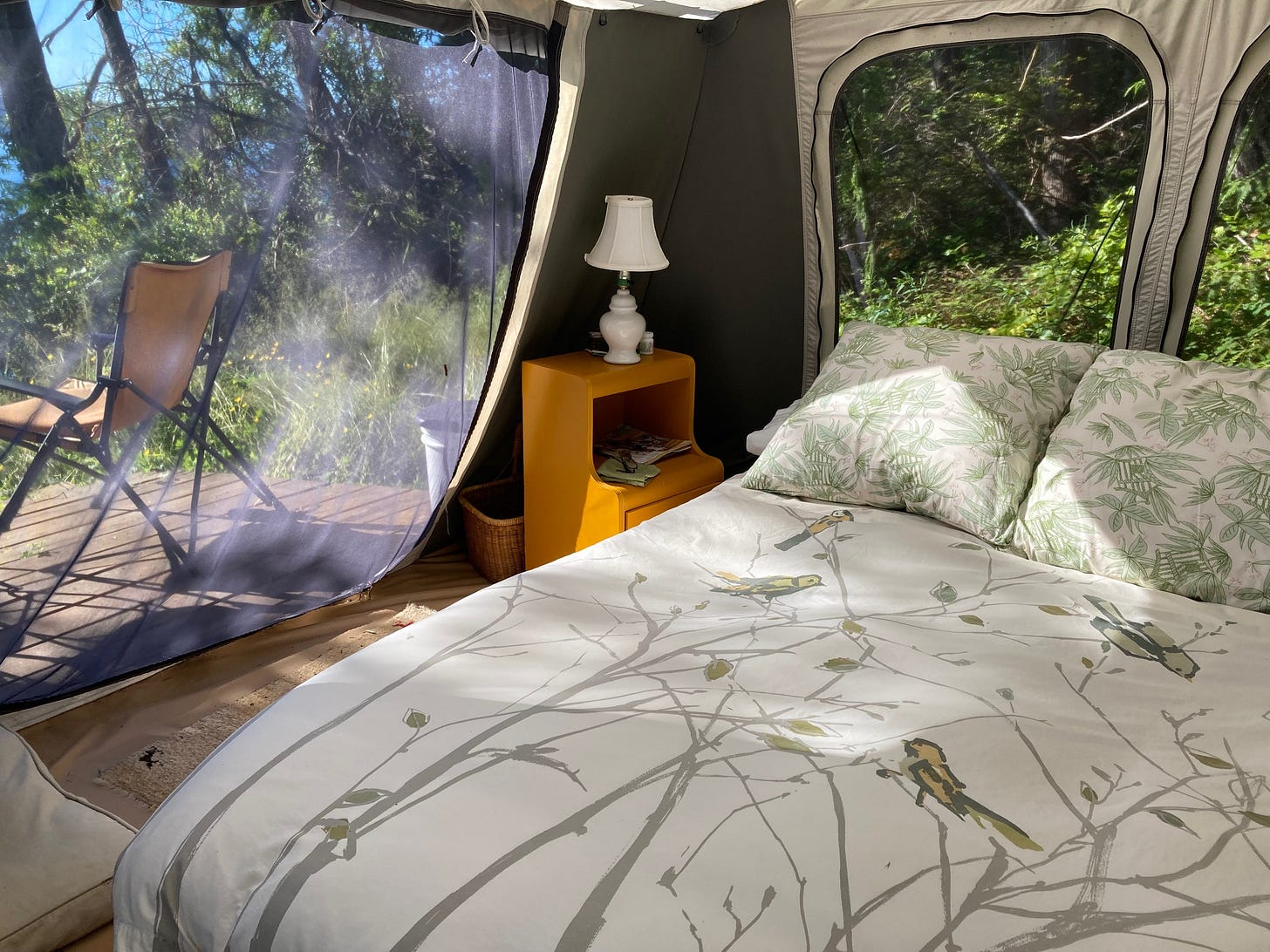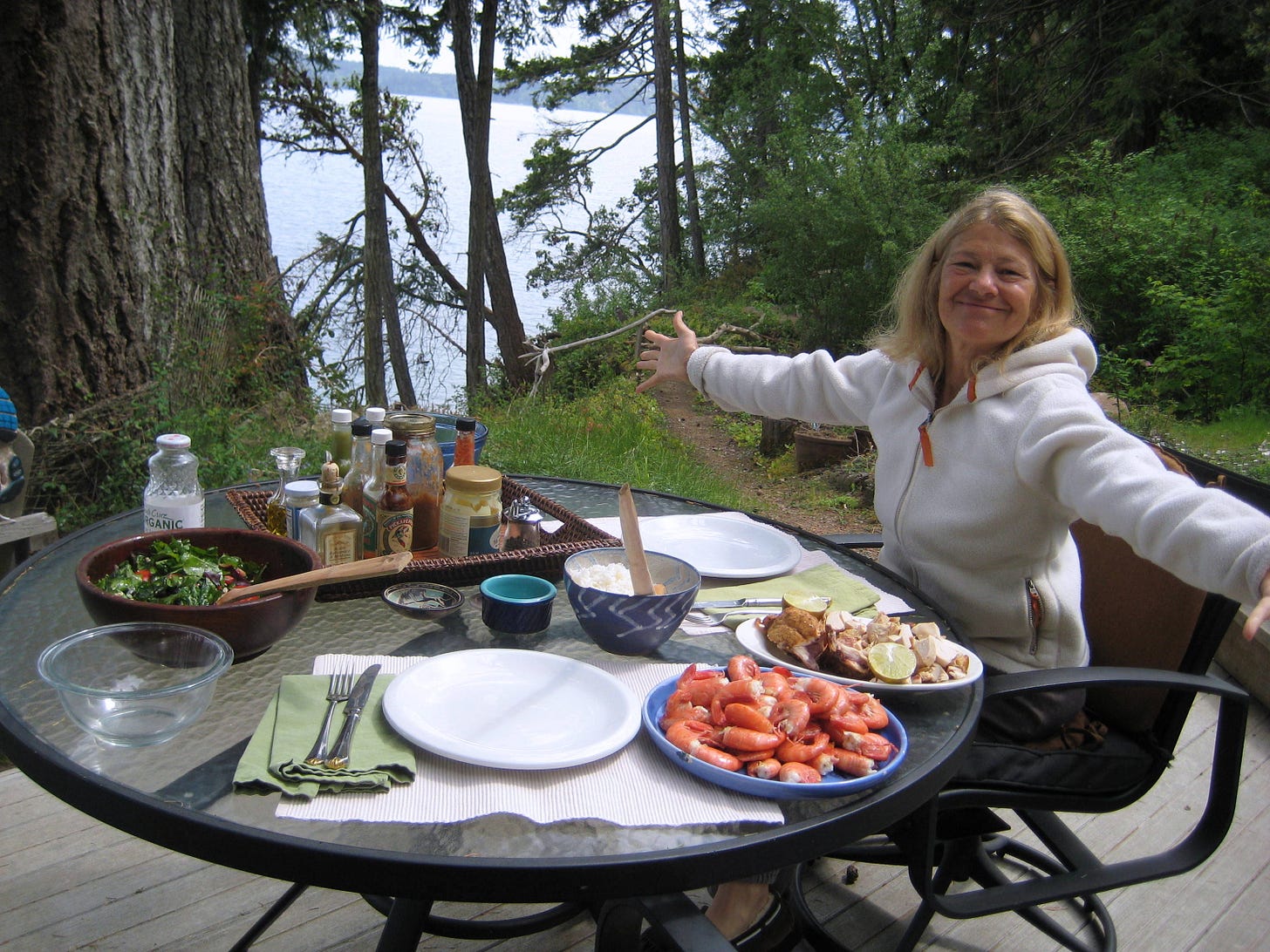Writing in Eagle Cottage
I’d write my thousand words a day. It was a form of praying, I see now. Carolyn See
July 1, 2022
I’d write my thousand words a day. It was a form of praying, I see now. Carolyn See
At three this morning, the sky is translucent pre-blue, crescent moon suspended just outside my tent. Because there’s no wind, the bay is silent: no sounds of humans or their machines, and even the birds remain quiet. By four, the birds begin their calls. I’m in a canvas tent on a cliff above the nation’s largest inland fjord. A few feet down the cliff is where my mother practiced transcendental meditation when we six kids, born in ten years, burst into adolescence.
“How unusual to live where you were born,” people say. The truth, though, is that for ten thousand years, the nəxʷsƛ̕áy̕əm̕ or S’Klallam (Strong People) walked along this cliff on their way to nearby summer villages. My parents taught that land cannot be owned, but only tended, and to that practice I have devoted much of my life.
Before I leave the tent, I drink my first coffee. My secret is small batches of freshly-ground local beans, brewed and frozen, then topped with cream.
I think of Tao Porchon-Lynch, dancing, teaching yoga, and writing into her nineties. “When I wake up in the morning, I know that it’s going to be the best day of my life,” she says. “I never think about what I can’t do. Make sure positive thoughts are the first ones you think in the morning. And never procrastinate.”
I turn to Czeslaw Milosz, whose “Collected Poems “sit beside me as I write:
Day draws near
Another one
Do what you can
In the cabin I designed and built over ten years while living in ancient trailers and tents, I brew stovetop espresso. Then I carry two cups and dark chocolate back to the tent. Alternating who starts first, my husband and I share whatever’s in our mind, stream of consciousness style. The practice is called talkback, but the other doesn’t respond. It’s about deep listening without judgement.
My golden retriever Hanne and I head off for our daily two-mile loop through the heritage forest that stretches from behind the tent, cabin, and writing hut. This trail is where I learned to walk, where my mother taught me names of plants and birds and trees. On this morning walk, I might have a one-sided talk with my mother, or I might do another practice I call the Three G’s: Gripes, Gratitudes, and Gifts. I used to start creative writing classes with this exercise, letting students know it was okay to be mad, okay to be sad, and also okay to be happy.
Just say it out loud, and then you can transform your pain or your joy into story or poem or drawing, I told them. And they did.
I maintain the property I occupy as a wildlife preserve for snakes, mammals, butterflies, and birds. On my morning walk, I see different bird species than those along the bay and bluff, and larger creatures or their tracks and markings as well. I’ve encountered the local Roosevelt elk herd, black bear, mountain lion, bobcat, coyote, and deer with newborn fawns so tiny they look like rabbits. I walk through fragrances I can’t quite trace, and I turn to pass that spot again to see if I can catch it this time.
I write in what was previously a 1924 schoolhouse. Around these parts, one can get permits to claim buildings due to be demolished and repurpose them. I call my writing shed Eagle Cottage. From here, as from the cabin and tent, I see harbor seals and their pups, and sometimes sea lions, porpoises, dolphins, or whales. The eagles flock in abundance, in part because this wild shoreline provides haven for easy food, Plainfin Midshipman, an ancient fish species that lives on land and sea. When not nesting and tending young, a Great blue heron perches directly above the deck. I love doing yoga in synchrony with this ancient bird.
As I have since childhood, I begin each day’s writing with a fountain pen in a notebook. E.B White said, “I took to writing early, to assuage my uneasiness and collect my thoughts,” and that’s how it works for me, too. Just as talkback with my husband eases us into the day, and the loop through the forest connects me with my ancestors and nature, so writing by hand connects me to myself.
At midday, I return to the main cabin where my husband and I embark on our cooking dance. Over the past decade, our remote rural area has drawn young people to start small organic farms. A nearby roadside stand features whatever’s fresh, paid on the honor system. We make our meals mostly from local scratch. Sometimes Mark’s the sous chef – his vegetables are works of art – and sometimes I am.
After our meal outside on the deck, I return to Eagle Cottage for daily writing sessions I call “ticks.” As soon as I pick up an active piece and start working, I’m pulled in. Anxiety assuaged. As Jia Tolentino says, “I can’t really think unless I’m writing.”
In the final hour of light, Mark heads into the forest with Hanne for their evening walk, and I return to the tent with piles of books. Besides forests and inland seas and wildlife and organic farmers, our county has a Bookmobile. We can request almost any book, and twice a week, the bus-sized library lumbers over the mountains and into our dale to deliver them. I just finished Honoree Fanonne Jeffers’ “Love Poems of W.E.B. Du Bois,” an 800-page epic. My husband and I often read the same books.
In the baby book my mother kept, she records my first word as “book.” Books are the love of a lifetime and writing part of that joy.
3 short-answer questions
1. What one word best describes your writing life?
Serene.
2. Please give us a few sentences about a work you love.
Ntozake Shange’s “For Colored Girls Who Have Considered Suicide When the Rainbow is Enough.” When I saw this play three times as a teenager, I felt transformed. I printed these lines on a notecard that sits beside me in my writing perch now: “I found god in myself & I loved her / I loved her fiercely.”
3. What is your strangest obsession or habit?
Just one? I write in what I call “ticks.” I set my phone timer for thirty-six minutes and six seconds and place the phone across the cottage, so I must get up when the alarm goes off. Then I take a break, preferably outside. I repeat “tick” five times per day. I like marking the four “sticks” in my planner and then drawing the crossbar to complete it.
Thank you Cynthia for your devotion to the writing life and for supporting other writers on Catching Days.
Learn more about prize-winning author, editor, speaker, and all around amazing person Cynthia Newberry Martin











Thank you for your kind words, Kirie, and you are so welcome. I'm glad you shared your beautiful day here in your space!
What a beautiful, peaceful, writing life! And a lovely reading meditation to start my day...many thanks!